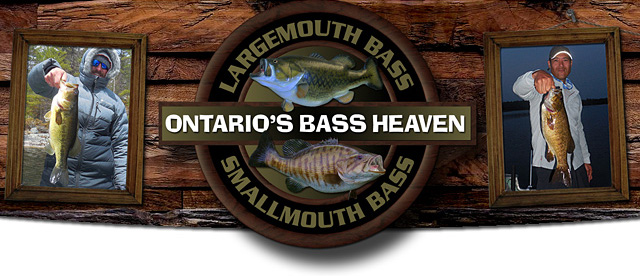Ontario Smallmouth Bass Tactics and Tips
a.k.a.--> brown bass, browny, bronzeback, smallie
The Smallmouth Bass is a slender, streamlined-shaped fish, which pound for pound puts up a fight that rivals any of the popular freshwater gamefish. No other fish jumps like a Smallmouth.
Smallmouth Bass are omnivorous in the food they consume. The Smallmouth Bass is a predator, feeding mostly on fish, crustaceans and aquatic and terrestrial insects. Where crayfish are abundant, they frequently comprise over two-thirds of the food.
Now that we know what they feed on, here are some tips when fishing for old Bronzeback in Canadian waters:
The most obvious spots to fish are rock shoals and drop off points. They also can be found in deeper water where the concentration of feeder fish are more abundant. A depth finder is invaluable in finding the best structure.
To cover large areas of water, diving crankbaits like Cotton Cordell's Rattlin Spot and the Rapala Shad Rap in silver or crawfish patterns are quite effective. When fishing shallow rock shoals, white and yellow spinnerbaits as well as shallow diving crankbaits have proven deadly. In deeper waters, a 1/4 to 1/2oz jig head tipped with chartreuse, yellow or white Mister Twister grubs are also effective. Slowly bouncing these jigs off rocky bottoms will surely entice the most wary Bronzeback. If fishing deep water in late summer or early fall, try bouncing a worm colored Tub Jig off the bottom. When Smallmouth do go deep, they seem to like the 30 to 40 foot depth range.
When These Methods don't work:
Some days you can throw every lure in the book at them and they will not hit. That's when you have to switch to live bait. Rock shoals and rocky points are the best spots for Smallmouth. What you should do is get a bass hook and put a big worm on. Let the worm dangle off the hook. Don't keep hooking it until it's a ball on your hook. Use light line like 4 or 6 pound test so you can cast far. With this method, you don't use any weight.
Cast your big worm at the shore's edge or over top of a shoal and let the worm slowly sink. As soon as it sinks down a couple of feet, gently pull the worm towards you until it hits the surface then let it sink down again. It's almost like you are taking long slow jigs. But make sure you pull it very slowly and gently. You will find that most of the time, the Smallmouth will hit the worm as it is sinking. You could put a weight about 3 feet up the line like a stretched Caroline Rig but when you are fishing in the rocks, a weight will get snagged. It's best not to use a weight even if you find it frustrating to cast.
You can use the same method with a Crayfish or a minnow. You can also use a small float about 2 feet up from the bait and cast over the rocks and just wait.
If you have touched a gas tank, gas line or get gasoline on your hands, scrub (wash) your hands with sugar. After you have put bug spray on, wash your hands with salt. Do this before you touch your lures to minimize transfer of undesirable scents. This will maximize fish strikes.



